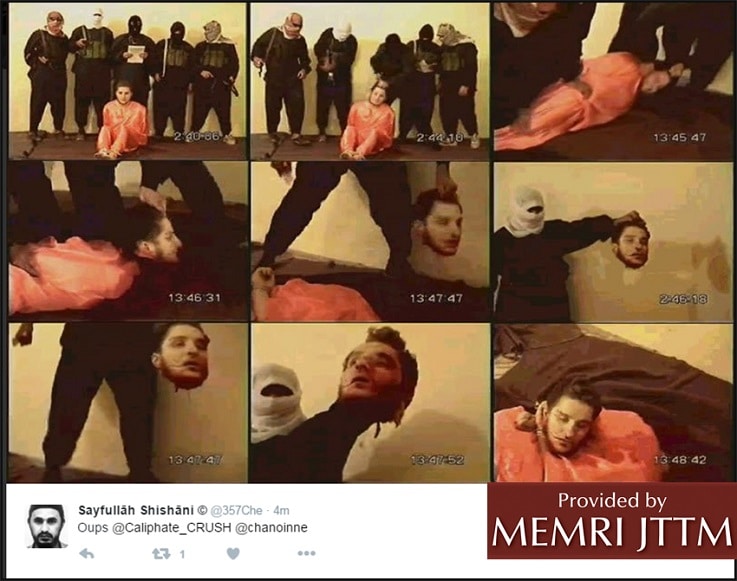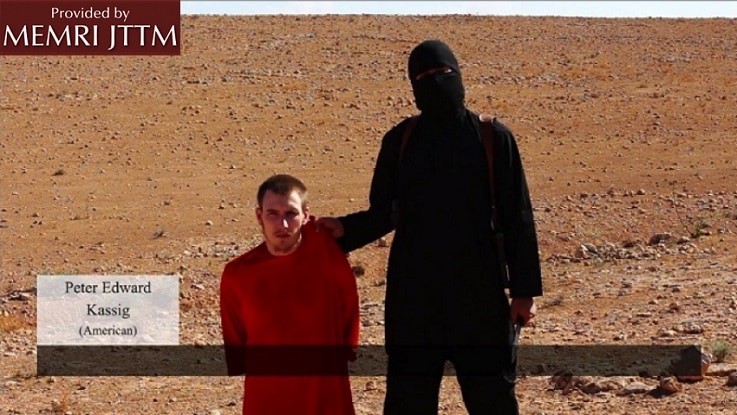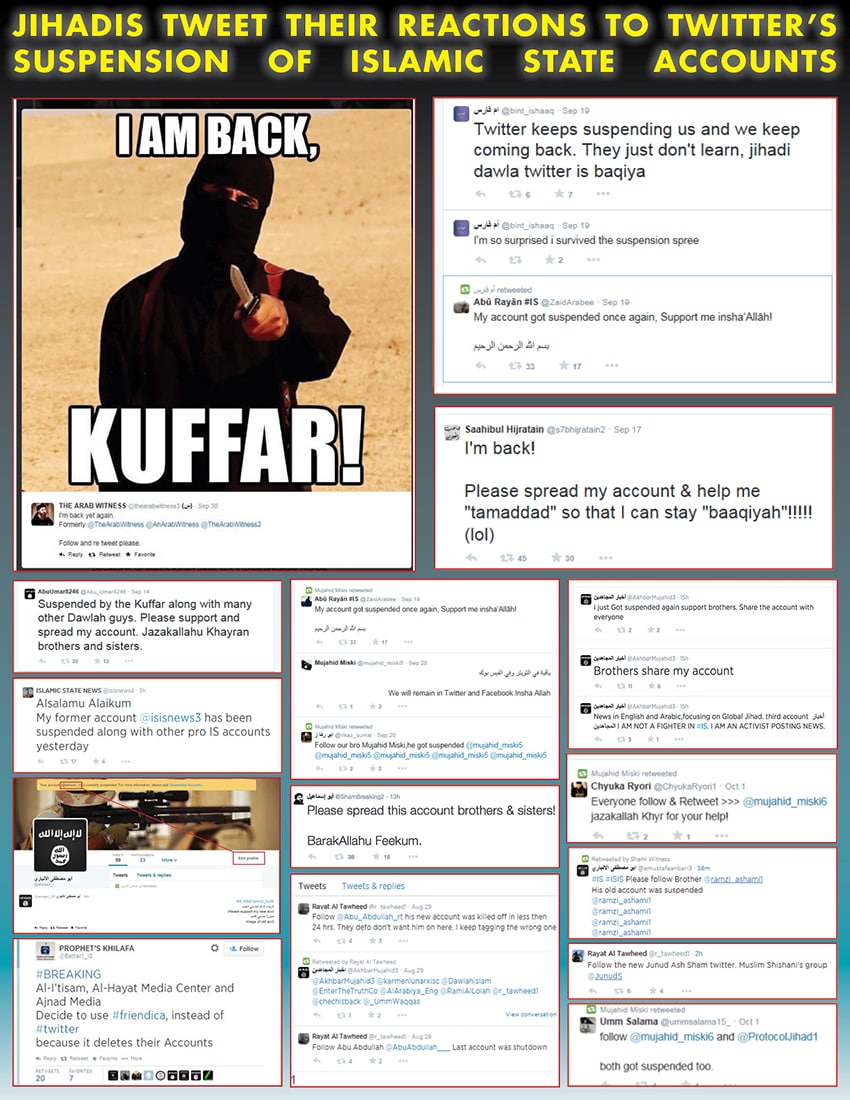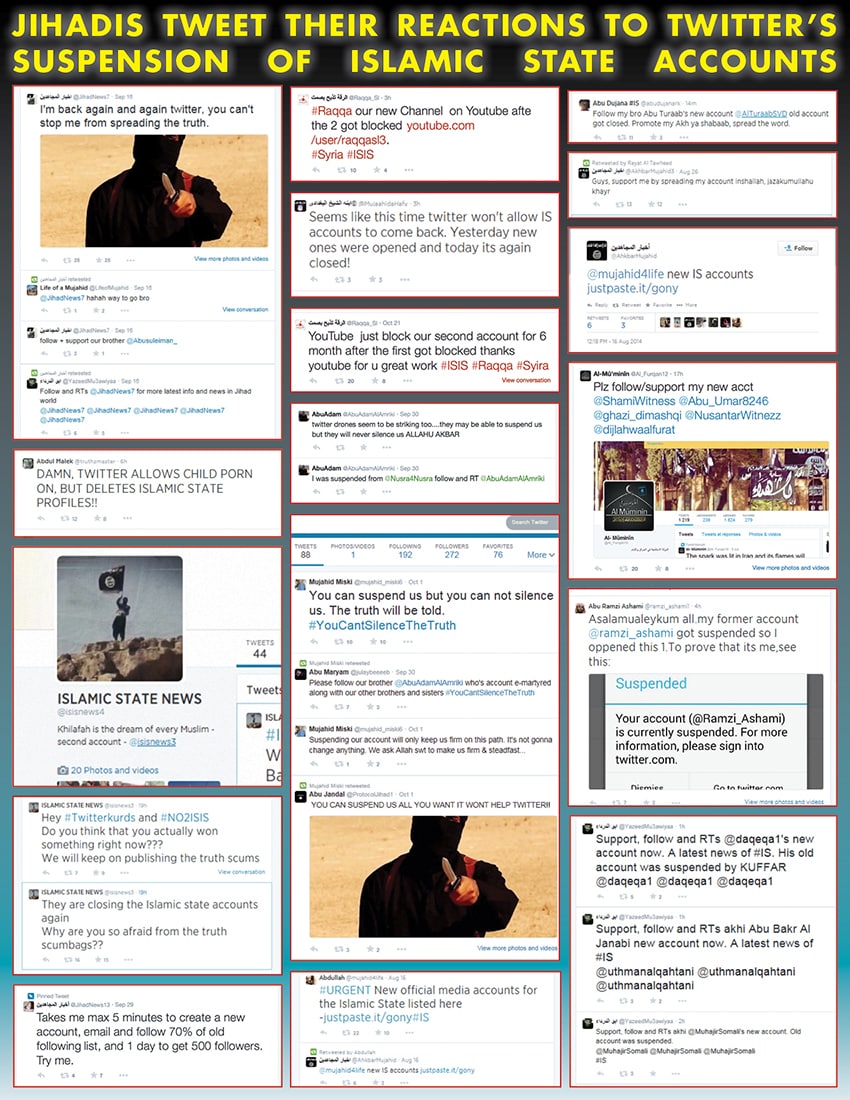WARNING: EXTREMELY GRAPHIC CONTENT
By: Steven Stalinsky, R. Sosnow, and M. Khayat*
"[With regard to] the slaughter of that American [Nicholas Berg] under the slogan 'Allah Akhbar': You know, in schools today... six- and seven-year-old children are shown how to slaughter, and the children have to shout 'Allah Akhbar.' There are thousands of terrified children... who cannot sleep at night... Can anything good come out of this generation? Murder has become our folklore."
MEMRI TV Clip No. 128 - Iraqi Writer Dr. Hisham Al-'Iqabi: Murder Has Become Our Folklore, June 9, 2004.
"What I'm aware of is about the three, four guys that we beheaded. And then we put the heads as usual in the town center. The reason for putting the heads in the town center, again, is to demoralize or cause fear into the hearts of the spies who are amongst us."
British citizen fighting with the Islamic State (ISIS) in Syria[1]

The following report is now a complimentary offering from MEMRI's Jihad and Terrorism Threat Monitor (JTTM). For JTTM subscription information, click here.
Foreword
Over the past few weeks, a debate has been emerging among leading legal scholars about the First Amendment and Islamic State (ISIS) activity on the Internet. On December 15, 2015, in an article in Slate titled "ISIS Gives Us No Choice But To Consider Limits On Speech," University of Chicago law professor Eric Posner called for greater speech curbs, noted that terrorist groups' increasing ability to use social media to recruit young people for their mission has "given rise to a historic and unprecedented danger from foreign radicalization and recruitment," and suggested "a law that makes it a crime to access websites that glorify, express support for, or provide encouragement for ISIS."
While some legal scholars disagreed, insisting that ISIS and other jihadi content online is protected free speech, a growing number are thinking differently. Erik Eckholm wrote on December 27, 2015 in The New York Times, under the headline "ISIS Influence on Web Prompts Second Thoughts On First Amendment": "It is one of the most hallowed precepts in modern constitutional law: Freedom of speech may not be curbed unless it poses a 'clear and present danger'... But some legal scholars are asking... whether it is time to reconsider that constitutional line... Should not the government have a way, they ask, to block messages that facilitate terrorist acts?" He noted that in November 2015, Harvard law professor and former Obama administration official Cass R. Sunstein had said that "it's worth asking whether that ['clear and present danger'] test may be ripe for reconsideration." He also pointed out that according to Posner, there is a need to "rethink the tradeoffs" of the First Amendment "as technology and society change." Eckholm wrote that while "all these legal experts, including Mr. Posner, agree that today's Supreme Court would strike down" a law such as the one suggested by Posner, they all agree that the court's thinking could change if more Americans indoctrinated by jihadi videos carry out terrorist attacks. He concluded by quoting University of Chicago constitutional law expert Geoffrey R. Stone: "Five years from now, who knows? You can imagine a scenario in which things get so terrible that you start watering down the protections."
Part of the focus of these legal scholars' discussions is the huge number of very graphic ISIS videos and images of Islamic punishments - beheadings, amputations, crucifixions, stoning and burning people to death, and throwing them off rooftops - that this and other jihadi groups have been freely posting on U.S. social media in the past two years, and that Al-Qaeda disseminated online prior to that. All those involved in this debate will find it hard to argue that this content should be protected free speech or that it should be online. Although this discussion is only now coming to the surface, for the past several years MEMRI has been documenting these Islamic punishments, as can be seen in the following report (WARNING: THIS CONTENT IS EXTREMELY GRAPHIC).
Preface: Setting The Stage For Today's Dissemination Of Beheadings On Social Media
In May 2004, the filmed beheading of American contractor Nicholas Berg by Al-Qaeda in Iraq leader Abu Musab Al-Zarqawi was posted by numerous jihadi websites, and widely reposted, setting the tone for many similar videos that would follow during the second Iraq War. It was found most recently on Twitter on December 14, 2015.

Nicholas Berg beheading (@357Che, December 14, 2015)
A few months later, in July 2004, the video of the beheading of Lockheed Martin employee in Saudi Arabia Paul Johnson Jr. also went viral, as did still images of his severed head in the hands of one of his murderers. Following that beheading, Al-Qaeda's Sawt Al-Jihad magazine wrote in an article titled "A Letter to the Wife of the Slain Paul Johnson From the Wife of One of the Martyrs" that warned: "We are just getting started, and the corpse of your husband shall be followed by mountains of corpses of his countrymen."
The video of the beheading of Illinois contractor Robert Jacob in Riyadh was posted online in June 2004, and those of the beheadings of Georgia engineer Jack Hensley and Michigan contractor Eugene Armstrong were both posted online in September 2004. In June 2006, the Mujahideen Shura Council, of which Al-Qaeda in Iraq was a part, claimed in an online statement to have "slaughtered" U.S. Army PFCs Thomas Tucker and Kristian Menchaca, suggesting that they had been beheaded.[2] While no videos of those killings have surfaced,[3] a video, released by the Mujahideen Shura Council, of the beheading of one and killings of two more of four Russian diplomats[4] kidnapped in Iraq that same month was released.

Left, Jack Hensley; right, Eugene Armstrong
Other online videos of beheadings in Iraq were of Italian photographer Salvatore Santoro and of Korean translator Kim Sun-il, both in December 2004, and of Japanese contractor Akihiko Saito, in May 2005.
In its September 11, 2013 editorial on the 9/11 attacks, the Tunisian daily Al-Haqaiq wrote: "The absurd thing is that the global terrorism mill, which had struck what it calls infidels in their bastions in New York, Madrid, London, and Moscow, later began harvesting the heads of thousands of Muslims in the mosques and markets of Iraq."[5]
During the Iraq War, and since then, jihadis have been beheading Syrians, Iraqis, and other locals. Turkish truck drivers and contractors were shown being beheaded in a video filmed in October 2004 in Iraq; a January 2005 video captured the beheading of Lebanese businessman Badri Ghazi Abu Hamzah, also in Iraq; also, a July 2005 video showed the beheading there of Egypt's Ambassador to Iraq Ihab Al-Sherif.[6] A video of two captured Algerian diplomats to Iraq, Ali Balarousi and colleague Azzedin Belkadi, was posted later in July 2005 by Al-Qaeda in Iraq; the group later reported that it had killed them.[7]
A popular terrorist confession television program, aired by Iraq's Al-Iraqiya and Al-Fayhaa channels, often focused on the subject of beheading. For example, on the February 23, 2005 show, captured Iraqi terrorist Shihab Al-Sab'awi explained how Syrian intelligence officials in Syria taught him to kill and behead[8]; the March 30, 2005 show featured another captured Iraqi terrorist, Omar Allawi, who said that he had been paid $200 to film beheadings[9]; and on the April 21, 2005 show, captured Iraqi terrorist Adnan Elias said he had killed hostages by disembowelment.[10]

In 2005, people were shocked by these early beheadings; today, a decade later, a new group has emerged in Syria, Iraq, and the region that makes these early beheadings seem tame.
Introduction: Islamic Religious Punishments In Iraq And Syria, The Emergence Of ISIS, And The Dissemination Of Images, Videos Via U.S.-Based Social Media
Since its inception, the Islamic State (ISIS) and groups such as the Al-Qaeda affiliate in Syria Jabhat Al-Nusra (JN), as well as other Al-Qaeda affiliates and offshoots, have used U.S.-based social media services as a vital tool to advance their goals - indeed, these social media have served them as a vital tool in their propaganda efforts. ISIS has used Twitter, YouTube, and other U.S.-based services to effectively strike fear into the hearts of both their enemies and of the residents of regions already under their control, with graphic images of beheadings, crucifixions, floggings, and other Islamic punishments.
The following report highlights how ISIS and the other organizations have used, and continue to use, U.S.-based social media to disseminate images and videos of these punishments; a history of jihadi beheadings on social media, including by Western fighters in Syria and Iraq; various categories of Islamic punishments posted on social media; and extensive examples of jihadi posts of beheadings, including videos.

These Islamic punishments, often handed down by local Islamic courts run by these organizations, and for which Koran passages are cited as justification, are being widely implemented against minorities, including Christians, Yazidis, Kurds, and homosexuals;[11] against members, or suspected members, of rival jihadi groups, of Syrian regime forces, of Hizbullah, and of Iranian armed forces; and against local citizens. Ample evidence of these punishments is being shared and circulated via these group's official accounts on social media platforms such as Twitter, YouTube, and others. These images are also being circulated by individual members and supporters of these groups, pro-Syrian regime elements, anti-regime elements, and others worldwide; MEMRI has been documenting these for three years.
Many times, these punishments are carried out in public in front of crowds of onlookers; the crowds often include children, and the events are used as indoctrination and instruction for the children. ISIS media releases feature many foreign fighters, particularly Europeans, carrying out these beheadings.
Monitoring this content is not an easy task; according to media reports, intelligence agencies, including the CIA, NSA, and National Counterterrorism Center, employ therapists to help analysts deal with the emotional trauma they experience from viewing and analyzing videos and images of beheadings and other graphic violence.[12] But it is vital to make the public aware of, and to document, the brutality of this content circulating on social media; doing so will help the West understand the opponent that it is facing.
Twitter, YouTube Terms Of Service Specifically Ban Publishing Of Graphic Violence
Major social media outlets' terms of service specifically prohibit the use of their services for sharing content such as the images and videos of beheadings, executions, amputations, floggings, and more that these jihadi groups are posting. It should be noted that prior to ISIS's beheading of American photojournalist James Foley and the posting of the video of the beheading on YouTube and of images from it on Twitter, these and other social media companies did little or nothing to remove such content - despite the fact that it violated their own terms of service.
Twitter's "Rules" currently state: "Violent threats (direct or indirect): Users may not make threats of violence or promote violence, including threatening or promoting terrorism. Users also may not make threats or promote violence against a person or group on the basis of race, ethnicity, national origin, religion, sexual orientation, gender, gender identity, age, or disability."[13]
YouTube's "Community Guidelines" state: "Violent or graphic content: It's not okay to post violent or gory content that's primarily intended to be shocking, sensational, or disrespectful... Don't encourage others to commit specific acts of violence."[14]
October 2013: ISIS Announces The New Islamic Law Of The Land
Executions and other death sentences, as well as amputations and floggings and the offenses for which they are implemented, were laid out in detail in the ISIS stronghold of Al-Raqqa, Syria in an October 2013 ISIS video disseminated via social media. As reported by the Lebanese Al-Jadeed TV, in a video, the "Islamic State in Iraq and Sham... recently issued a statement in Al-Raqqa showing prohibitions (Islamic laws) and offenses punishable by flogging [first] and end[ing] with death."
The video stated that "Islamic laws" included bans on makeup and jeans for women and mandatory burqas for girls; a ban on smoking, and mandatory closure of men's barber shops and banning of haircuts, the violation of which is punishable by death. Violators of the new ban on smoking would have their "index and middle" fingers amputated, and, if they did not kick the habit, would be further punished with "80 lashes and up to their execution." Women must be treated only by female doctors, no jeans "with waist" may be worn by young people, and there must be no "modern hair styles and use of gel," with 80 lashes for violators. Women are also banned from "sitting on chairs."[15]
Burqas For Girls; Smoking Is Punishable By Death, Amputation Of Fingers, 80 Lashes, And Execution

No Haircuts, "The Violation Of 'Death'"; 70 Lashes For "Words Or Disagreement With" ISIS

December 2014: (ISIS) Publishes Penal Code, Says It Will Be Vigilantly Enforced
On December 15, 2014, a document detailing the ISIS penal code was released on the Jihadi Media Platform forum (alplatformmedia.com). Titled "Clarification [regarding] the Hudud [Koranic punishments]," it listed crimes and their respective shari'a punishments. ISIS said that it was publishing the document as a warning and a reminder to the people living under its rule, and reiterated its commitment to be vigilant in its enforcement.
The document begins with various Koranic verses emphasizing the need for Muslims to adhere to the shari'a, noting that those who do not are considered unbelievers.

The crimes and punishments listed include:[16]
-
Blasphemy against Allah: Death
-
Blasphemy against the Prophet Muhammad: Death - even if the accuser repents
-
Blasphemy against Islam: Death
-
Adultery: Stoning to death if the adulterer was married and 100 lashes and exile if he or she were unmarried.
-
Sodomy (homosexuality): Death for the person committing the act, as well as for the one receiving it.
-
Theft: Hand amputation
-
Drinking alcohol: 80 lashes
-
Slander: 80 lashes
-
Spying for the unbelievers: Death
-
Apostasy: Death
-
Banditry:
-
Murder and stealing: Death and crucifixion
-
Murder only: Death
-
Stealing (as part of banditry): Cutting off the right hand and the left leg
-
Terrorizing people: Exile.
-
ISIS Grabs World Attention - By Posting Videos Of Beheading Of Western Hostages
For the first time since the mid-2000s, beheadings made headlines, on August 19, 2014, with the release of an ISIS video showing the beheading of American photojournalist James Wright Foley by a hooded man with a British accent; the video, titled "A Message to America," and images from the beheading were widely shared on social media. The video, which was first released by Al-Hayat Media via social networks, soon went viral, with download links posted on the Internet Archive (archive.org), Twitter, and YouTube.
The video also featured Steven Joel Sotloff, another American hostage in ISIS custody, and threatened that his fate would be the same as Foley's if the U.S. did not stop its attacks against ISIS. Sotloff was beheaded two weeks later; on September 2, ISIS released a video showing Sotloff's beheading, titled "A Second Message To America." In the video, the executioner threatened to also kill a Briton being held hostage by the group.
A video of the beheading of British humanitarian aid worker David Haines, titled "A Message to the Allies of America," was released by ISIS on September 13; one of the beheading of British humanitarian aid worker Alan Henning was released October 3, 2014; and one showing that American aid worker Peter Kassig had been beheaded, along with the beheading of Syrian soldiers, was released November 16, 2014.

James Wright Foley, Steven Joel Sotloff

David Haines, Alan Henning

Peter Kassig
Segments of the Foley beheading video were posted on LiveLeak as well; two days after the beheading, on August 21, 2014, it issued a statement about the video that read in part: "The last 24 hours have been a fairly intense affair here on LiveLeak given the sheer volume of traffic we've dealt with from people looking for the James Foley beheading video... The actual video concerned does not show the beheading of James Foley although it does show a graphic image of the aftermath. We chose to show it because it's within our remit to show such items given this is an outrageous and horrific act... We thought it was important to show this video and allow those who chose to view it the right to do so." It added: "There is every chance - given the rumors of hostage stockpiling [by ISIS] currently doing the rounds - that that we could see a return to the dark times of 2004/5 when beheadings happened with an alarming and depressing regularity... [As a result, w]e will not have regular beheadings from IS[IS] on the site."[17]
Twitter Shuts Down ISIS, Other Jihadi Accounts
The day after Foley's beheading, on August 20, 2014, following the widespread tweeting of the video and images of the event, Twitter CEO Dick Costolo tweeted, "We have been and are actively suspending accounts as we discover them related to this graphic imagery. Thank you." Nevertheless, the release of the videos of ISIS's next four beheadings of Americans and Britons were all announced via Twitter - with more graphic images of the beheadings and their aftermath. Furthermore, four months later, the number of graphic jihadi tweets of beheadings and executions was at its peak.
Additionally, just prior to the beheading, Twitter had already launched a mass shutdown of accounts belonging to ISIS; even before that, Twitter had begun to remove some accounts of designated terrorists. In many cases, however, as soon as the accounts were shut down, new ones were immediately created to replace them.
When Twitter began to remove ISIS accounts, many ISIS supporters openly discussed what was happening, ridiculing Twitter's removal of their accounts with comments such as "Takes me 5 minutes max to create a new account, email and follow 70% of old following list, and 1 day to get 500 followers, try me"; "You can suspend us but you cannot silence us, the truth will be told"; and "Damn, Twitter allows child porn but deletes Islamic State profiles." They also widely tweeted and retweeted information on new accounts replacing the closed ones, with messages urging followers to "please spread this account brothers and sisters" and the like.


Tweets Of Beheadings Continue Despite Twitter Account Shutdowns
Despite Twitter CEO Costolo's announcement that accounts tweeting images of beheading would be suspended, ISIS and ISIS supporters continued to tweet images of the beheadings of Foley, and later Sotloff, Haines, and Henning. The tweets included hashtags referring to the titles of ISIS's videos of the beheadings, as well as messages such as "[Only] if the crowing and weepers [can] ponder on what the orange shirt of the Crusader infidel [i.e. Foley] symbolizes/Thank you #ISIS #JamesFoley"; "If you don't stop your crazy Obama from killing our People in Iraq so that will be your destiny"; "This British citizen will pay the price for your promise oh Cameron to arm the Peshmerga against the Islamic State"; "Here is the [Islamic] State response"; "Call upon Allah and slaughter/replied God is great/for the Islamic nation revolt/for your deed today we are proud"; "This hero [the executioner] wiped the ground with Cameron"; "Cameron threatened us! And the response of our State was a blow to the neck..."; and "Our knives will continue to stab the necks of your citizens."

The full text of this post is available to subscribers.
Please login or register to request subscription information from MEMRI





